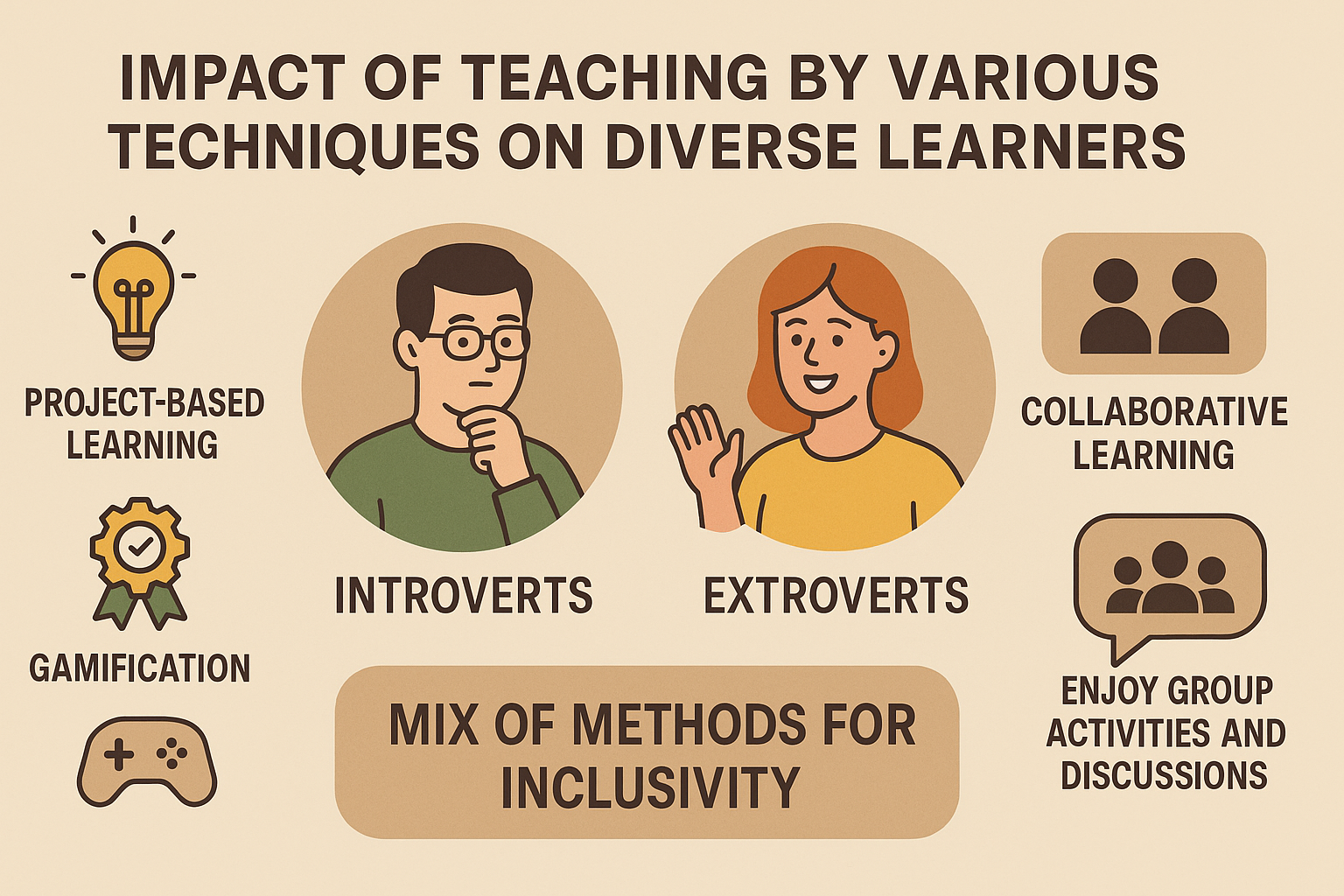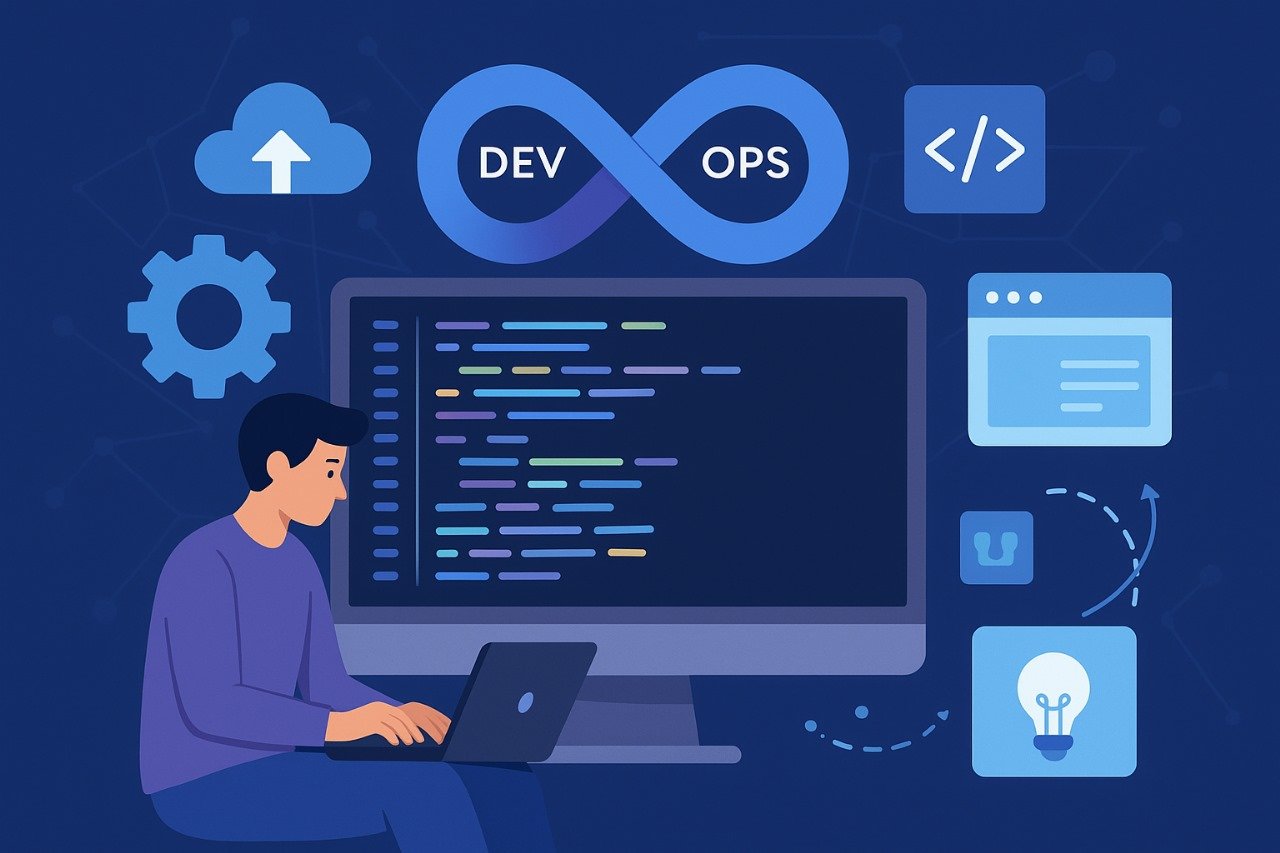Abstract: This paper looks at how different teaching methods impact student learning, paying special attention to individual personalities and learning styles. Based on six years of qualitative classroom observations by an IT faculty member and recent educational research, we examine techniques such as hands-on sessions, project-based learning (PBL), gamification, and collaborative exercises. We compare how introverted and extroverted students respond to each method. For instance, interactive, student-centered approaches like active learning, PBL, and labs usually lead to better results than traditional lectures, but extroverted and introverted students benefit in different ways. Extroverted students enjoy group activities and discussions, while introverts tend to do better when they have time to reflect, write, or work alone. Our qualitative findings, backed by published studies, suggest that using a mix of methods and carefully organizing group work can engage all learners. Instructors should offer a variety of experiences, such as live coding demonstrations and quiet programming tasks, team projects, individual assignments, and gamified contests alongside reflective activities, to meet the needs of different learners. Throughout, we highlight insights from the faculty's observations and relevant literature, focusing on how and why certain strategies work well or present challenges for specific students. This broad view can help instructors create inclusive IT courses.
Introduction
In recent years, higher education has moved from passive lectures to more interactive, student-centered methods, especially in STEM and IT fields. Educational leaders, like UNESCO and ABET, support active instruction instead of traditional lecturing because studies show it improves student achievement. Examples include hands-on labs, project-based learning, team-based learning, flipped classrooms, and gamification. These methods boost engagement, critical thinking, and real-world skills. However, students are not all the same; personality and learning preferences are important. An extroverted student might enjoy oral discussions and contests, while an introvert may withdraw unless given quiet time or opportunities for written reflection. This paper looks at how different teaching techniques affect diverse students, especially introverts and extroverts, based on an IT faculty member’s six years of experience and current research. We focus on qualitative insights, examining the instructor’s observations of student behaviors and engagement, interpreted alongside empirical studies.
Teaching Methods and Their Effects
Modern classrooms use a variety of techniques. Below, we outline key methods and summarize what research and the experience of an IT faculty suggest about their effects on learning and different types of students.
- Practical (Hands-On) Sessions: Involving labs, demonstrations, and hands-on activities allows students to apply concepts directly. Experimental learning engages multiple senses and reflects real work, like coding exercises and hardware labs. Extroverted students usually enjoy volunteering for demonstrations or discussing results in groups, while introverted students gain from handling tools and quietly checking outcomes. Adding these activities, as shown in the figure below, boosts engagement because students build understanding through doing, not just listening.
- Project-Based Learning (PBL): PBL assigns real-world projects over extended periods, such as building an application or designing a layout. The instructor acts as a coach while students investigate, collaborate, and present their results. Research consistently shows that PBL improves outcomes. A recent meta-analysis found that PBL significantly increased academic achievement, thinking skills, and attitudes across various disciplines. Notably, PBL had especially large effects in engineering and technology courses, including IT, and was more effective in lab settings than in pure theory. In the classroom, project tasks allow students to explore topics in depth. Extroverts often thrive in team roles and public presentations of their work, while introverts excel in research, coding, and writing that remains private. Both types can benefit. Extroverts enjoy collaborating with peers and presenting ideas, while introverts often excel when given clear solo tasks, like documentation or coding, within the project. However, without careful structure, some introverts may retreat. The literature on collaborative learning suggests dividing projects into defined roles or allowing smaller subgroup brainstorming so introverted students can find a comfortable niche.
- Gamification: Applying game elements like points, badges, leaderboards, and competitions to learning aims to boost motivation. In IT education, instructors may use coding contests, digital badges for milestones, or gamified quizzes. Studies show mixed effects of gamification based on personality. Overall, gamified environments can increase engagement, but their impact varies. One experiment with programming students showed that introverts on a gamified platform earned more points and logged in more often than extroverts, suggesting they became highly engaged, possibly due to clear goals and feedback. Other research finds that extroverts may prefer competitive badges and rankings, while some introverts are sensitive to public comparison. For example, Codish and Ravid (2014) reported that ranking systems sometimes discouraged extroverted students but were less harmful for introverts. In contrast, another study found that extroverts were motivated by points and levels. In practice, I see that gamification can energize the class. Extroverts enjoy contests, while introverts appreciate quiet, game-like problem-solving. However, the design must be careful. Leaderboards and competition should balance with cooperative or anonymous elements to avoid disadvantaging shy students. Providing both individual and group game tasks can harness extroverts' enthusiasm while allowing introverts to participate at their own pace.
- Collaborative and Active Learning (Team-Based, Peer Instruction): Techniques like Team-Based Learning (TBL), peer instruction, and discussion groups require students to work together on problems. These approaches increase class interaction and accountability. Our literature source notes that collaborative methods such as case-based learning, simulations, PBL, and labs focus on group interaction and responsibility. While these methods generally boost engagement and skill development, they often favor extroverted learners. Extroverts thrive on interaction and show high energy in group settings. Introverts, on the other hand, often struggle. They might avoid leadership roles, hesitate to speak up, and feel anxious in fast-paced, unstructured groups. For instance, introverted medical students in one study reported fears of being judged and were reluctant to take charge in team tasks. In IT classes, an introverted student might be great at coding but say little during group debugging sessions. As a result, faculty have learned to support group work by assigning mixed-ability groups, defining sub-teams like research, coding, and testing, and rotating roles to give introverts time to prepare before speaking. Techniques such as think-pair-share allow quiet students to reflect alone before discussing, which improves their participation.
- Flipped Classroom and Blended Learning: Flipped instruction, where students watch lectures at home and use class time for practice, along with blended models, gives students flexibility. Instructors find this setup especially helpful for introverts. They can take in new material on their own and ask questions later. Online discussion forums or reflective assignments allow introverted students to contribute at their own pace. Although there aren’t many specific studies on flipped models and personality, general advice for inclusive teaching supports providing different ways to communicate. For example, one medical education guide points out that introverted students often think before they speak. Therefore, offering low-pressure options like written polls or digital chats to share ideas is helpful.
- Traditional Lectures (Passive Instruction): Conventional lectures are still used, especially for teaching theory. However, studies show that lectures lead to lower learning gains than active methods. In classrooms, faculty noticed that introverted students often disengage during pure lectures. They tend to focus on note-taking and may not ask questions. On the other hand, bored extroverts seek interaction. A meta-analysis by Freeman et al. (2014) found that active learning results in higher exam scores, with an approximate standard deviation gain of 0.47, compared to traditional lecturing. Therefore, it is better to keep lectures concise or mix them with questions and short activities to engage both groups.
Student Personality Types and Learning Preferences
When adjusting instruction, it is important to consider different learner profiles. The most noticeable difference is between extroverted and introverted students. Real classrooms, however, contain a mix, including ambiverts and various types. Other key differences involve communication preferences, such as verbal versus written, and cognitive styles, including analytical versus big-picture thinking. We will focus on extroversion and introversion because these traits significantly influence class dynamics.
- Extroverts (Outgoing, Social Learners): Extroverted students gain energy by interacting with others. They usually learn best in lively, social settings like group projects, class debates, discussing problems out loud, and hands-on teamwork. Extroverts "talk to think," which means they express ideas while reasoning. Instructors often notice extroverts raising their hands quickly, forming study groups, and feeling at ease when speaking up. Because of this, activities that involve a lot of discussion or competition tend to engage them. However, extroverts may overlook details, so pairing them with reflective peers can help create balance. The literature also suggests that extroverts might be driven by external recognition, such as points or badges.
- Introverts (Quiet, Reflective Learners): Introverted students prefer to reflect alone before they speak. They need time to develop their ideas internally. Introverts often do well with independent work, deep analysis, and creative thinking. However, they may seem shy or disengaged when constant public interaction is necessary. Our faculty has observed that many introverts excel in written assignments, coding projects, or prepared presentations. Research highlights this difference: introverts like written communication and thoughtful tasks more than spontaneous responses. In group situations, introverts may stay quiet unless prompted. Teachers should ensure that introverted voices are heard by using strategies such as small-group discussions, written polls, or scheduled speaking turns. It’s important to note, as Susan Cain and educators indicate, that introverts represent a significant portion (30 to 50%) of any class. Their strengths, like focus and creativity, should be nurtured just as much as those of extroverts.
- Other Learning Styles: Although the differences mentioned are most noticeable, students also vary in other ways. Some learn best through visual aids like diagrams and charts. Others prefer auditory methods such as lectures and discussions. Some learn by doing through hands-on activities. While researchers debate the “VARK” learning styles model, it is clear that providing multiple ways to learn benefits everyone. For instance, combining code demonstrations with written instructions and group brainstorming addresses various preferences. The key is flexibility. Some students might like clear, step-by-step lab instructions, while others prefer open-ended project brainstorming. Experienced faculty often mix presentation styles to accommodate these differences. They might use slides and live coding, in addition to assigning reading and video content for review.
- Ambiverts and Others: Many students lie between the extremes. Ambiverts adjust to different situations; they can speak up when they feel comfortable and also work alone when necessary. Adapting to both styles often benefits ambiverts. Other personality traits, such as conscientiousness and openness, along with background factors like culture and prior experience, also impact learning. However, extroversion and introversion are still the most important influences on classroom interaction. In our qualitative focus, we primarily observe who prefers group work versus solo tasks and those who like quick responses versus those who take time to think; this largely reflects the E/I axis.
Qualitative Observations from the IT Faculty
Over six years of teaching undergraduate IT courses, such as programming and networking, the faculty member observed how students with different personalities reacted to various methods. These insights are based on personal experience and match findings from research studies.
- Participation and Communication: The instructor noticed that extroverted students often start questions and answers in class, energizing group work. In one programming class, extroverts led whiteboard coding sessions and eagerly explained their thought process out loud. Introverts, on the other hand, usually listened first. When asked directly, many introverts provided well-formed responses, but only after a brief pause, showing that they were “thinking to talk”[5]. Research in education warns that a classroom favoring extroverts can make introverts feel out of place[3]. The faculty learned to ask questions while allowing wait-time and to invite written reflections, like quick polls, so introverts could share comfortably.
- Group Projects: In team assignments, extroverts often stepped up to be spokespersons or leaders, pushing the group forward. Introverts usually took on roles like system design, documentation, or coding, working hard behind the scenes. In one software project, a typically quiet student produced a flawless piece of code that solved a tough problem, showing how introverts can succeed without a lot of recognition. This aligns with findings that introverts frequently use collaborative learning strategies, such as extensive note-taking and individual study, when working in teams[18]. Importantly, teams that mixed different personality types performed the best. Extroverts shared ideas during discussions, while introverts added depth. However, if a team had many strong extroverts, some introverts would pull back. To solve this, the instructor sometimes created pairs or small sub-teams so introverts could participate in a more intimate setting, which studies have shown is important[6].
- Gamified Activities: Introducing gamification, such as weekly coding quizzes with points, had different outcomes. Some extroverted students aimed for the top of the scoreboard and enjoyed public recognition through badges and rankings. In contrast, introverts who were uncomfortable in the spotlight found the competition stressful. Interestingly, in one semester, the instructor noticed that introverts earned more badges and logins on the gamified learning platform than extroverts. This supported research showing that introverts can engage well with game elements. The instructor realized that gamification should let students participate anonymously or at their own pace, such as by allowing them to earn points through solo challenges. This approach would help introverts engage fully without feeling social pressure.
- Assessments and Feedback: In informal evaluations, extroverted students often did well in oral presentations and lab demos. Introverted students performed better on written reports and take-home projects. The faculty responded by diversifying assessment. By pairing presentations with written reflection assignments, they provided students with multiple ways to show their learning. This supports the idea that participation includes more than just speaking. Thoughtful questions, volunteering for help sessions, and completing optional exercises all count. The instructor noticed that acknowledging these “quiet contributions” validated the efforts of introverted learners.
In summary, the faculty’s experience showed that no single method works best for everyone. Effective teaching involves mixing techniques and being aware of who benefits in what ways. This finding aligns with the literature’s guidance on inclusive teaching. For instance, adjusting group work with structured roles and different formats, along with including individual tasks, can support introverts while keeping extroverts engaged.
Recommendations for Inclusive IT Instruction
Based on these observations and supporting research, we outline several guidelines for instructors:
- Mix Multiple Techniques: Use a mix of lectures, hands-on labs, projects, and discussions. For example, start a topic with a brief explanation. Then show a live coding demo. After that, let students work on exercises in pairs or on their own. Switching methods stops any one personality group from taking over or losing interest. Active methods should be more common than passive ones. As a rule, include at least one interactive element, like a quiz, discussion, or problem-solving activity, in each class.
- Structure Group Work: When assigning team projects or in-class groups, carefully form teams with diverse personalities. Assign specific roles, such as facilitator, recorder, and coder, to give introverted students clear duties and comfortable ways to contribute. Consider mixing physical and virtual communication, like online chats for questions. As one study suggests, provide structured social engagement and adjust group assessments to fit different learners[19].
- Allow Think-Time: In Q&A or brainstorming sessions, always allow some wait-time. Ask a question and count to a few seconds. Encourage students to write down their thoughts before sharing. Alternatively, use think-pair-share so introverts can think about their answers privately or with a partner first. This approach respects the reflective style that introverts often prefer.
- Diversify Participation Modes: Re-define participation broadly. It goes beyond just raising hands. Participation includes writing forum posts, putting together study guides, peer mentoring, or even taking part in extra-curricular hackathons. The instructor can clearly state that asking insightful questions or helping classmates also counts as participation. This recognition encourages introverts to engage in ways that feel comfortable to them.
- Use Technology Thoughtfully: Tools like polls, online quizzes, and coding challenge platforms can engage students in a way that keeps their identities private or allows them to participate at their own pace. Introverts might feel more comfortable joining in through a digital or written format instead of speaking out loud. For instance, an in-class audience-response system can show how well introverted students understand the material without putting them under pressure. Likewise, features that add game elements should be optional and tailored to each student, such as earning points for solving problems independently, to ensure fairness for everyone.
- Communicate High Expectations for Everyone: Instructors should actively demonstrate that they value both extroverted and introverted strengths. Praise quiet students when they contribute, whether through writing or coding, and encourage extroverts to think deeply about their contributions. Faculty and course designers are encouraged to support both types of learners equally. For example, showing how an introverted student’s careful coding helped the team succeed confirms their worth, just as we would celebrate an extrovert’s presentation skills.
Conclusion
Effective teaching in IT, and in any field, requires differentiation. My review of six years of faculty observations, supported by recent studies, shows that teaching methods affect learners differently based on their personality and style. Active, practical, and project-based methods usually improve learning outcomes[1][2], but instructors need to customize these approaches. Extroverted students often do well in group games, oral tasks, and interactive settings[3][4]. In contrast, introverted learners excel with individual problem-solving, written work, and well-structured interactions[5][6].
Qualitative insights from an experienced IT faculty show that combining techniques and intentionally designing activities to include silent reflection and social engagement creates an inclusive classroom. For example, a lab session might allow students to work alone on an experiment, which benefits introverts. After that, they can form teams to discuss results, engaging extroverts. Teachers can observe and make adjustments. If a method regularly isolates certain students, it should be modified. One guide points out that strategies should be developed
In future work, these observations could be supported by student feedback and numerical measures, like exam scores and surveys, to confirm the faculty’s impressions. However, this study shows that to have the greatest effect, IT educators should regularly reflect on how their teaching style connects with student personalities. By recognizing different learning styles and personalities, instructors can help all students, whether they are outspoken or quiet, reach their full potential.





















